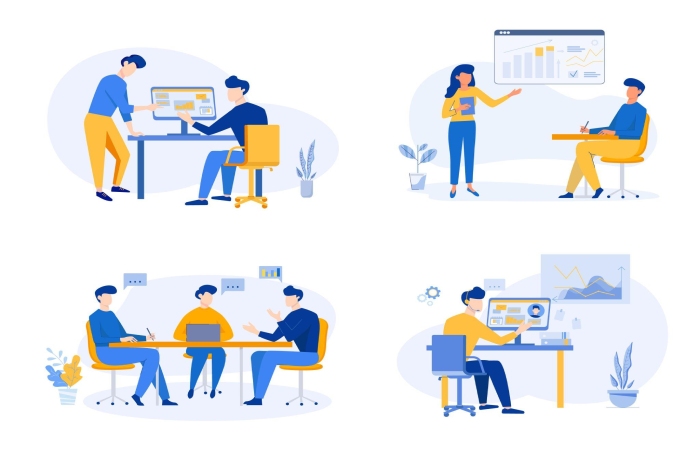Introduction to Customer Analysis
A customer analysis (or customer outline) is a critical section of a company’s business or marketing plan. It identifies target customers, determines the needs of those customers, and then specifies how the product meets those needs.
Customer analysis can be divided into a behavioral profile (why your product fits into a customer’s lifestyle) and a demographic outline (describing a customer’s demographics).
A customer profile is a humble tool that can help businesses better understand current and potential customers to raise sales and grow their business. Customer profiles are a collection of customer information that can be used to determine why people will or will not buy a product. Customer profiles can also help develop targeted marketing plans and ensure products meet the intended audience’s needs.
How to do a Customer Analysis?

“It is no lengthier enough to have a good product to be competitive. If we don’t know our clients well, if we don’t take care of them in such a way that they notice it positively, some of them will soon notice the difference”, affirms the business school, and that is one of the main reasons why you need to know how to carry out the customer analysis.
Large companies and companies have departments dedicated solely to obtaining information from their consumers, which becomes a complicated situation in the case of small and medium-sized companies (SMEs) or independent entrepreneurs when we are dedicated to sales and do not have a long time or Budget! Carry out such research.
However, if we want to retain our customers and expand our portfolio, we need to take that time and figure out who is buying from us, so we know where to direct our distribution capabilities.
Customer Analysis Aspects
The first references must be from current customers who already know you, have approached you, and have repeatedly purchased goods or services.
We are talking about your current market and your customers who are influential consumers and buyers.
In this case, Entrepreneur magazine highlights two advantages SMEs have over large corporations concerning customers. These two situations occur thanks to its size, which is about proximity to customers and personalized treatment.
Being close to your buyer’s lets you know their tastes and consumption preferences. This proximity facilitates the generation of a relationship since links are created between the parties, where benefits are sought for those involved in the operation.
And this closeness also facilitates the second advantage: personalized treatment, which “allows you to understand and improve the sales process, closely attend to customer needs, solve problems more effectively and have more direct communication.” – Entrepreneur.
The information you can obtain from your clients will show how satisfied or dissatisfied they are with your services. On the other hand. It will indicate how to keep them as clients and allow you to replicate the business with more people.
By performing this analysis. You will be able to determine the common characteristics that identify those who acquire your products or services. This is called segmentation.
Data You get in Customer Analytics
- Geographic location.
- Education level.
- Marital status (Single, married, divorced, family existence, and also several children).
- Business social networks.
- Reasons why they prefer your products to those of the competition.
- Identification of who they see as your competition.
- Loyalty level is if they always consume your product or are trying several.
- Learn about their consumption patterns. What are the products they consume? How often do they sell? Please find out how much they are affect by price variations, their response to offers, or the submission of various forms of payment…
- Technology to which they have access.
- Specific needs regarding a good or product.
- Psychological aspects related to their values, beliefs, personality, and interests.
- Members of the company who make purchasing decisions.
“This data can be place in a CRM program for analysis to create an offer more absorbed on your tastes and also preferences. And even for the personalization of offers.”— Entrepreneur.
Lost Customers
When doing this customer analysis, also consider locating data on customers who only bought from you once or those who did so all the time and suddenly stopped.
“We must remember that the cost of capturing a new client is three or four times greater than that of recovering the one that left. You already have information and knowledge of your old client. Which gives you an advantage in your strategies and costs.”— Entrepreneur.
This will help you to have the information of the reasons for the abandonment and also, incidentally, you can consider some strategy to recover it. Among the aspects that you can investigate are the following:
The client. Your purchasing characteristics, what the competition offers you, and the reasons for changing providers.
The mistakes. If this is the case, review what mistakes were made. See if they can be correct, and also consider letting your customer know about it.
The problem. Identify it well because it may not have to do with the product or the price but with the service or communication with the client. This data will facilitate the process so that it does not happen again and opens the possibility of recovering the lost client.
The Key is Knowledge.
Knowing your customers is what differentiates your marketing actions. It’s key to understanding who they are, what they get from your business, and also what competitive advantages you can offer them.
With this data, you can focus your marketing efforts. When it is so important to optimize resources, it will help you. Knowledge will make a difference.
Conclusion
Customer analysis is use to map the external environment of a business. And also it is part of the situation, CICD, and also external analysis. The result of the customer analysis serves as input for the SWOT analysis. Conducting customer analytics enables a business to respond to the opportunities and also threats that customers bring.


